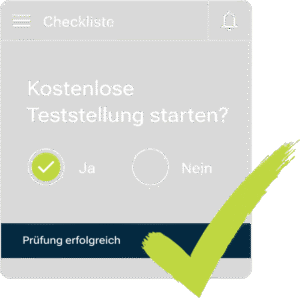
Quality management generally comprises all organizational tasks that serve to improve or achieve process and product quality. In other words, quality management, or QM for short, is a core task for management.
In some industries, QM systems are required by law, such as in aviation, aerospace, the automotive industry, medicine, pharmaceuticals and food production. However, many other industries also use QM systems as part of the continuous improvement process in their operations.
What is meant by QM system?
QM can be described as an organizational system that ensures the quality of goods, services and processes, which are then compared with customer requirements. QM can be divided into 4 major areas: Planning, Control, Inspection/Audit & Improvement/Optimization. QM methods and tools have been established to carry out the individual tasks and are described below.
These are the goals of QM.
The aim of a QM system is not to continually improve the quality of manufactured products, for example. This means that a manufacturer of low-cost products can also have a good QMS that monitors compliance with the customer’s specifications. The aim is not to achieve the best possible quality, but to achieve the previously defined quality target. It is important to understand that it is not the products themselves that are used for certification (ISO 9000), but the (business) processes that are necessary to create the products.
Quality planning – planning is half the battle.
Product planning is the preparation of the future quality that a product or service requires and is therefore an essential part of quality management. As part of planning, all technical and organizational measures are recorded that prepare, accompany and check the creation and maintenance of a previously defined quality standard.
The quality management standard EN ISO 9000:2015 describes quality planning as part of quality management, which is aimed at defining the quality objectives and the necessary execution processes as well as the associated resources to meet the quality objectives.
A key task in this phase is to record the quality requirements of customers and suppliers.
A variety of quality planning tools are available to management for quality planning:
– APQP – Advanced Product Quality Planning
– FMEA – Failure Mode and Effects Analysis
– QFD – Quality Function Deployment method
– Conjoint Analysis
– GAP Analysis
– Inspection control plan and inspection plan.
The declared aim of quality planning is to implement the customer’s requirements and quality characteristics.
Quality control – prevention, monitoring and correction
Quality control, also known as quality regulation / quality control, is the “part of quality management that is aimed at the fulfillment of quality requirements” (DIN EN ISO 9000:2000-12). Through its work and activities, quality control is aimed at monitoring processes as well as improving and optimizing unsatisfactory results. The measures derived from the results of quality planning can relate to the product, the manufacturing process or the personnel deployed for production.
Quality control distinguishes between indirect and direct quality control. Direct quality control has an effect on the activities and means of realization during the realization of the unit. Indirect quality control improves the quality capability of the people and resources used to implement the unit and can therefore only take effect during future implementation.
The two best-known components of quality control are complaints management and document control.
Quality control/testing – determining the quality characteristics
Quality control/testing is the concrete determination of whether products or services fulfill certain conditions and is therefore an essential part of quality management. Quality control/testing therefore serves to operationally determine the extent to which a product or service meets the quality requirements. Depending on the area of application, the inspection can be based on hard or soft factors.
With digital tools for quality control, data can be recorded and analyzed directly on a mobile device. CAQ systems, which record and analyze measurement data digitally in some cases, are used in industrial environments in particular. Objective tests are primarily used in production: These measure & record physical properties (length, width, weight, density, speed), for example, and are evaluated in the quality control chart. In addition, processes for creating products are also increasingly being tested. Efficient data collection and preparation of the data in dashboards for monitoring defined KPIs forms the basis for success here.
As already explained, there are different quality inspection options for each sector, industry and department. The best-known options are:
– self-inspection / self-monitoring
– sorting inspection
– 100% final inspection / classification inspection
– sampling systems / statistical quality control
– outgoing goods inspection (manufacturer) / incoming goods inspection (customer)
– external inspection bodies – test laboratories, measuring rooms, test institutions
Digital web apps already support digital collaboration across company boundaries, where the entire product value chain can be mapped on a single database.
Quality improvement – analyzing information and findings
Today, quality improvement characterizes the most important activities of quality management. The aim of quality improvement is to constantly ensure that the quality capability within the company is increased through suitable measures and that it can therefore react more flexibly to market or customer requirements. The most important part of this is the establishment of appropriate structures to raise quality awareness among all employees, for example through an operational improvement system (BVW) or a continuous improvement process (KVP), in order to achieve product and process improvements, as these make a significant contribution to quality improvement.
DIN EN ISO 8402 (1995-08) describes quality improvement as follows: “Measures taken throughout the organization to increase the effectiveness and efficiency of activities and processes in order to achieve additional benefits for both the organization and its customers.” In practice, quality improvement is achieved through internal audits and the resulting corrective measures, as well as through corrections following errors, external complaints and statistical findings. Preventive measures are taken before an error occurs, often on the basis of risk analyses.
Methods for quality improvement in the company:
– Kaizen / KVP
– PDCA cycle
– Six Sigma
– Total Quality Management
– Quality circles
– Business Process Reengineering
– Performance-related pay systems
– Company suggestion scheme
– Benchmarking
Conclusion
Quality management means using a management system to ensure that the expected and defined requirements for the quality of the company’s services (products and services) are met efficiently and effectively. This requires coordinated activities to manage and control a company or organizational unit with regard to the quality of operational processes and conditions. They usually include the definition of quality policy and objectives, quality planning, quality control, quality assurance and quality improvement.
Quality management is therefore the totality of all measures to improve processes, products and services.
Would you like to control your quality processes and make quality measurable? Please contact us.




